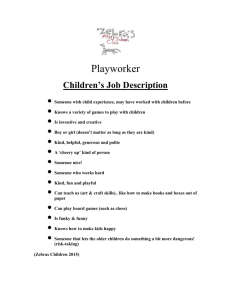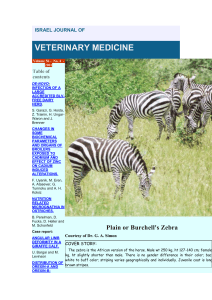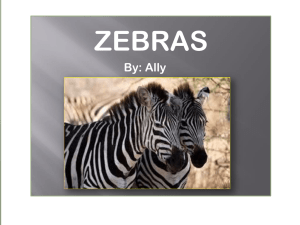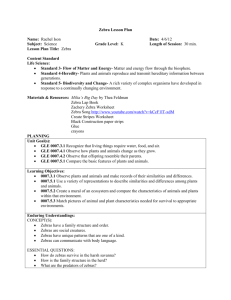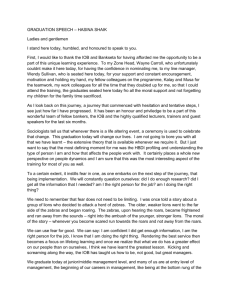Zebras
advertisement
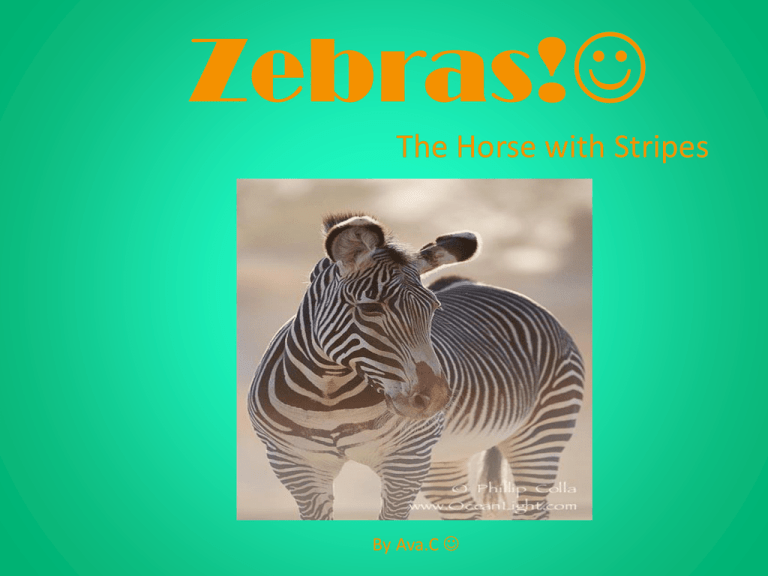
Zebras! The Horse with Stripes By Ava.C Introduction! Scientific name is Equus Quagga They live 20-30 years in the wild In captive Zebras have reached 40 years old They are endangered because farmers are building crops so they are taking away their home and humans are hunting for their skin to make rugs, coats and blankets They are mammals Physical Features! They are 7 to 9 feet tall They weigh between 440 to 990 The head has large round ears like a mule Black with white stripes The stripes go all the way under their belly Looks like a horse with stripes The stripes are vertical on their body More Physical Features! On their legs the stripes are horizontal Zebras are not as large as a big horse The hair along a zebra’s neck stands up instead of hanging down like a horse’s mane When their mane comes up to their head it looks like a mohawk Their eyes are located on the side of their head, widely spaced Even More Physical Features! Short legs Some have narrow stripes all the way down to their hooves Their hooves are similar to horses hooves They are odd toed that means they have a odd number of toes on each hoof Black or dark muzzle Long snout Not 2 zebras have the same stripes Habitat! Savannas and grasslands from Sudan to northern Zimbabwe in eastern Africa The only home they have is in Africa Some zebras live in dry or hilly areas There are lots in South Africa because it’s warm and has lots of open land What Climate Zebras like! In the Winter the temperature can get as low as 40 degrees below zero In the Summer it can get up to 70 degrees It rains 10 inches a year It is sunny 90 percent of a year Landforms! • Rocky terrain because some of their predators can’t run that fast on rocky places • Open woodlands • Grassy mountain slopes What Foods Zebras Eat! Zebras are plant eating animals called herbivores. They love to eat: Grass Shrubs Twigs Leaves Fruit Buds Hunting! Prey of… Lion Leopard Hyena Cheetah Hunting Dogs Predator to… none because zebras are herbivores How They Act! They are social animals Zebras sleep standing only if a group of zebras are there to warn them for danger If they spot an animal they will nay or bark loudly to warn others of danger They live in herds They wrestle with their necks and kick with their front feet Zebras are alert and active Babies! Baby’s can stand up for 20 minutes after it’s born It can run when it’s only 1 hour old Zebras foals are born with brown and white stripes They stay in their mothers belly for 12-13 months Young zebras live with there parents for 3 years Physical Adaptations! Their furry body helps them in the winter to stay warm Its long legs help them run really fast Their hard feet called hooves help them when they are running so they don’t step on something Their shiny coat reflects heat so they don’t get too hot or dehydrated Their black and white stripes help them camouflage so that their predators can’t find them Their front teeth are more delicate than the back teeth so zebras rarely use their teeth for fighting because they could get injured Physiological Adaptations • Their running muscles are near the shoulders rather near the leg because all the weight would slow them down • They have sharp teeth to help them cut grass-- they are like scissors • Their long necks help them reach the grass on the ground • Their flat back teeth help them to crush and grind the grass • Their night vision is as good as an owl’s which helps them see their predators. Behavioral Adaptation! • Kicks animals or runs away quickly to stay safe • A frightened zebra shows its teeth to scare off predators and their ears are forward • Not all zebras live in groups, lots of zebras live alone. When they live in groups they protect each other. All the males team up and protect the females and babies • The families always stay together and they never get lost. This helps keep them safe. • If there is a lot of food they are happy to hang around the savanna. But, if there is a shortage of food they migrate to a new savanna. The Zebra’s Future! Mountain zebras and Grevy zebras are endangered, but the Burchell zebra is extinct 30 years ago there were 100,000 zebra. Now there are close to 2,000 zebras left Since the Burchell zebra is extinct they were one of the most popular zebras. Now that they are gone there are not that many zebras left Fun Facts! There are 3 different kinds of zebras: Mountain zebras, Plain zebras and Grevy zebras A group of zebras is called a herd Zebras are part of the horse family They run 35 miles a hour If a zebra and cheetah were racing in an obstacle course, the zebra would win. Cheetahs can only run fast when they run straight. They never stop growing
